Positive Health Online
Your Country

ME / Chronic Fatigue Syndrome - Causes and the Amygdala Retraining Recovery Programme
listed in cfs me long covid, originally published in issue 157 - April 2009
ME, also known as Chronic Fatigue Syndrome (CFS), affects approximately 250,000 people in the UK. As yet, there is no agreement in the medical profession as to the cause of the condition, or how to effectively treat it. I personally suffered from ME/CFS myself around 10 years ago, and I had it for over 3 years. Through medical research, I managed to get myself 100% better, and I have been well for many years. For the last 10 years I have been researching ME/CFS and treating patients at my clinic in Harley Street; my medical hypothesis was published in a peer reviewed journal in 2002.[1] I have developed an effective recovery programme based on my own experiences and research.
Initially I was only treating patients at my clinic, but found that many patients could not manage the journey to see me, or that they could simply not afford the treatment programme. Therefore I devised an interactive DVD recovery programme for patients, which seems to be very successful for those who have used it.
In this article, I will describe my hypothesis as to the causes of these conditions. I believe that ME/CFS is a real physical condition with real physical symptoms, and is not a psychological illness. I believe it is ultimately caused by neurological abnormalities in a brain structure called the amygdala. I believe that this hypothesis applies to Fibromyalgia as well, with some minor differences.
The Amygdala Hypothesis
The amygdala is in the unconscious brain. It's a small almond shaped structure in what is called the 'limbic system' of the brain, and in fact there are two of them.
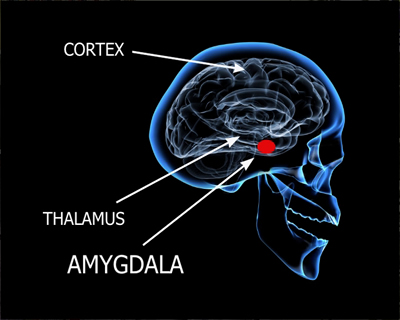
Many emotional reactions are handled by the amygdala, including fear and anger. One of its main functions is to protect the body from danger. To do this it takes in information from the outside world through the 5 senses – we shall call these stimuli – and then interprets whether these stimuli represent a threat.
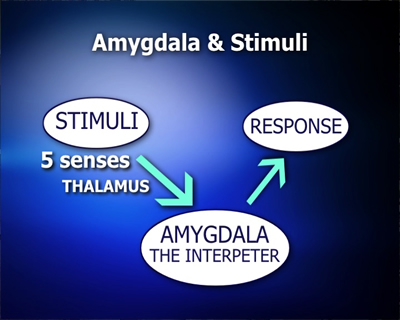
Stimuli come in from the left through the senses. All the information is put together in a brain structure called the thalamus. The thalamus then sends this information all packaged up to be interpreted in the amygdala, and then the amygdala creates an appropriate response. If it is dangerous, it then creates a protective response using connections it has to many other brain structures and the whole body. In the next diagram, you can see that there are incoming stimuli on the left; they get interpreted by the amygdala as to whether something is dangerous or not, and then the amygdala triggers responses on the right hand side.
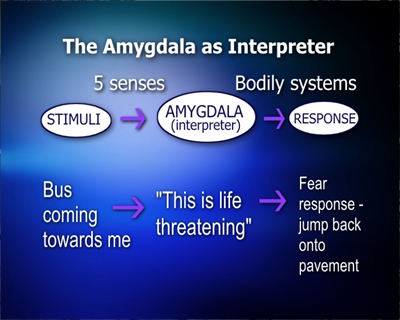
Let me give you an example. Imagine when you step out onto the road and there is a bus coming towards you. Your senses hear the bus and then see the bus, transferring information instantly to your amygdala. The amygdala has to make a split second decision as to what to do, and it will instantly send electrical signals to your legs and get you back onto the pavement. All of this will happen in milliseconds without your conscious mind being involved. You can see the benefit of this, because if your conscious mind was involved, it would take too long to process all the information.
Now what happens when you first realize that you nearly got run over by a bus? I'm sure you would feel a shudder as you stepped back onto the pavement. That shudder will probably be accompanied by some anxiety or fear, basically a feeling of "Oh my God, I nearly got run over by a bus!" Let me explain what is happening.
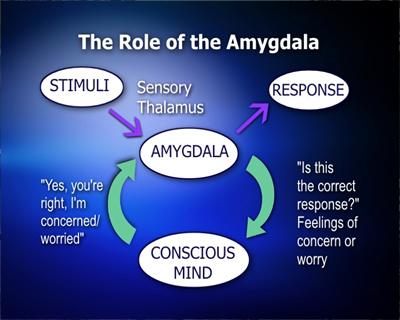
In the diagram, the amygdala has sent a message down to the conscious mind, filling the conscious mind with fearful thoughts on the right hand side. That's when you have the thought of "Oh my God, I nearly got run over by a bus...I must be more careful next time", and you shudder at what might have happened. The reason the amygdala does this is because it wants to check that buses are dangerous. It knows that you are more intelligent than it is, and there might be a reason why buses are not dangerous. It enters into a dialogue with your conscious mind.
As soon as this happens consciously, where you feel that frightened feeling, if you don't question the frightened feeling, you unknowingly send a message back to the amygdala confirming that it was correct, that buses are dangerous. It must protect you next time there is a bus. The logic the amygdala uses is that if I can create worrisome thoughts and feelings in the conscious mind with the emotion with them being interrupted, then I must be triggering the correct protective responses. If the conscious mind does not challenge how I made it feel, then that must mean that my actions were correct. However if the conscious mind isn't bothered by the danger and thinks its no big deal and doesn't buy into the fearful feeling, then maybe buses are not that dangerous.
The amygdala's protection mechanism also holds the clue to ME/CFS. These unconscious protection mechanisms can sometimes get programmed to over-protect us, and that's when problems can arise. A mild example of this is a phobia or a panic attack, where the amygdala over-protects us and makes us feel anxious to something that we shouldn't be so anxious about. So if someone had a phobia of spiders, it is the amygdala which is over-reacting to the spider and getting the conscious mind carried away with it.
The Initial Cause of ME/CFS
In my experience, with most people the condition tends to start during a particularly stressful period in someone's life. So from what we talked about earlier, you can imagine what is happening.

Lots of stimuli are coming into the amygdala on the left hand side, the amygdala sees a lot of these things as threatening, and so it sends up emotionally charged thoughts up to the conscious mind on the right hand side, trying to alert you to the threats to get you to deal with these threats. At the time, a person may have been overcome with these negative thoughts, which means that the amygdala gets lots of messages back that they are in danger on the left hand side. In fact, a lot of people talk about feeling overwhelmed at the beginning of the illness, just not being able to deal with everything, and feelings of "I can't cope". This is basically where the amygdala keeps feeling under threat.
At this point, a unique bit of brain neurology comes in to help us understand how ME/CFS starts. The amygdala becomes 'sensitised' – this means that because it is on high alert from all the stressful stimuli coming in from the senses, it can stay on high alert to everything and it is difficult for it to calm down.
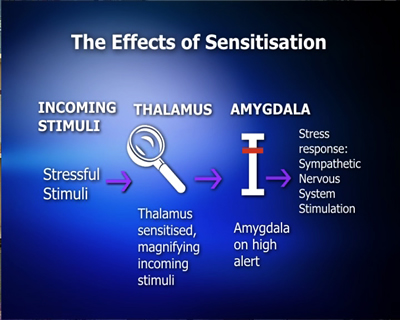
In the diagram we can see how the stimuli come in from the left, and the stimuli are magnified by the thalamus, which has also become sensitized. This is represented by the magnifying glass. The thalamus magnifies anything it senses. These messages are then sent to the amygdala. Imagine the amygdala to be like a volume slider control you might see on a hi-fi or a TV, which goes up and down. The slider control predicts how stressed you are feeling, and is sometimes known as the 'anxiety thermometer'. When the mind is relaxed, the slider control is at the bottom, and stimuli come into the amygdala, but the amygdala is subdued and does not respond dramatically. However, when the amygdala is sensitized, the slider control is at the top, ready to respond to any stimuli it feels.
So imagine, your amygdala is firing off all the time, and when your amygdala fires off it triggers a whole load of changes in the body through something called the sympathetic nervous system. It uses a variety of pathways, one being a brain structure called the 'hypothalamus'. Stress hormones are released into the blood constantly, muscles become tense, adrenaline pumps through the body, digestion is shut down, blood is diverted to muscles, sugar is released into the blood stream, and a whole host of changes go on in the body. Now as we have all heard, when we have stress in the body, this affects our immune system. The power of the immune system is reduced, so it can't respond to viruses, bacteria or other toxic dangers as well. Therefore it is prone to attack.
Studies show that around 70% of people with ME/CFS can remember a particular virus or toxic trigger at the beginning of the illness, from which they never seemed to recover from. When the body is trying to deal with a virus/toxin, the body perceives that it is under threat and it will divert energy away from non-essential functions towards fighting the virus. As an example, we've all had the experience of having flu where our whole body aches, we feel weak, nauseous, and we blame it on the flu virus. However, it is not necessarily the flu virus itself that is causing these symptoms. It is the triggering of the immune system and the resources being diverted away from other functions in the body.
So we have two coincidental things going on in the body:
- A particularly stressful period in someone's life, mentally, emotionally or physically. This reduces the power of the immune system;
- A virus/bacteria/other toxin in 70% of cases.
Because of the stress, in a lot of patients, the virus seems to last longer than usual because the immune system is lowered, and a person feels run down for quite a while. Once again there is a minority of patients who don't remember any particular virus, but it could be that the body may have still been fighting something at some point near the beginning of the illness. Because of the lowered immune system, it takes a lot longer than usual for the illness to go, and even once the illness has gone, a person may still feel run down and tired. This is often known as Post-Viral Fatigue or PVF, and is common in the population. Many people who are run down take longer to recover from a virus or other illness than people who are healthy. For patients with Fibromyalgia, I believe the same process is occurring, but rather than a viral or bacterial trigger, the trigger tends to be some kind of physical injury or pain.
So there are now two things contributing to symptoms in the body at the beginning of ME/CFS. One is the symptoms from the Post Viral Fatigue or PVT, and the other is from the stimulation of the sympathetic nervous system, with adrenaline and other chemicals tiring the system.
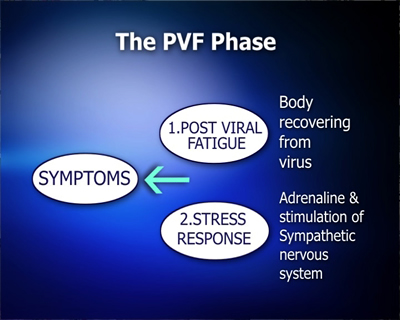
I remember thinking back to when I first got ill, and I remember saying things like: "Gosh, why is it taking so long to get better?" "When will these symptoms go away?" "I'm fed up of feeling like this". "I'm a conscientious person, I've got work to do, I can't be ill!" Gradually I was getting more and more concerned about why I was not getting better, and this was stressing me out even more.
Now according to some ground breaking research by Professor Joseph Ledoux,[2] when the amygdala becomes sensitized, it becomes very prone to learning new things to become sensitive about. As an example, if you get stressed about one thing, it then becomes very easy to become stressed about something else. And because near the beginning of the illness, a person might be very concerned about what is going on, a person may inadvertently train the amygdala to become sensitized to the symptoms. And because the amygdala is sensitized, it very quickly starts sending messages up to the conscious brain as well saying "Hey, the body is exhausted, what's going on, this is dangerous isn't it?!" "Your body is weak, do something!" This can then cause further conscious negative thoughts, which in turn trigger off the amygdala, creating a negative vicious circle. This may also be occurring completely unconsciously as well.
In the diagram we can see that the conscious mind and the amygdala are negatively reacting to how the body feels, and this results in stimulation of the stress response. This adds to symptoms already being experienced as a result of PVF. This is aggravated by the fact that a person may go from doctor to doctor trying to work out what is going on, as well as reading negative information about ME/CFS on the internet or in books. This can make someone feel even more negative.
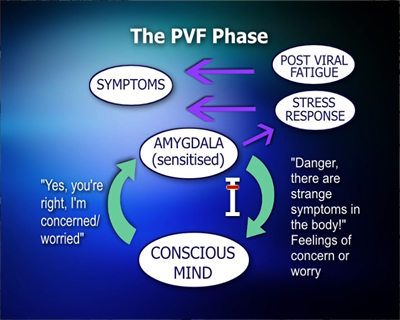
I have certainly noticed that many of my patients generally tend to be very driven people, and this may increase the negativity towards the symptoms. So for example, a person may become more and more agitated at not getting better, and therefore the frustration and annoyance trains the amygdala even more that something is wrong. This creates a trauma in the amygdala. This is the beginning of ME/CFS. Research shows that some ME/CFS patients have characteristics of someone who has a lowered immune system, and some have an elevated immune response. Well, there is evidence that even immune reactions can become conditioned to a particular stimulus, so being unconsciously concerned about symptoms may trigger off certain immune responses, because it reminds the body of when it was first trying to get over the original virus. For instance, if you give rats some sweet water with a virus, the rats' immune system gets triggered. Eventually if you do this enough times, if you simply give the same rats the sweet water without the virus, they still trigger their immune responses. So immune responses can also be part of the conditioning.
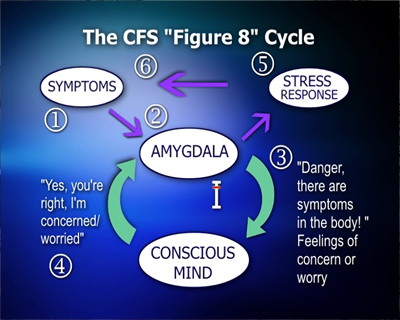
The ME/CFS "Figure 8" vicious cycle is then set up. On this diagram, let's start at position 1. There are symptoms in the body such as tiredness caused by too much stimulation of the nervous system. The amygdala is now sensitized to symptoms, and let's say a symptom is sensed by the amygdala at 2. The amygdala has been trained to treat symptoms as dangerous, and triggers negatively fuelled thoughts up to the conscious mind at position 3. The small slider control in the amygdala shows that the amygdala is permanently on a high state of alert. The conscious mind gets carried away with the feelings and creates negative thoughts about symptoms, sending a message back to the amygdala at position 4 that something is wrong, which then tells the amygdala to keep releasing the stress response at position 5. The overactive stress response then creates many symptoms in the body at position 6 through the release of adrenaline and other chemicals, which double back and become the same thing the amygdala is sensitive to – the symptoms...so you can see quite easily how the body gets stuck and symptoms continue relentlessly. The body is stuck in a temporary cycle where it keeps reacting to its own reactions.
Furthermore, any other external stresses now become exaggerated because the amygdala is on high alert to all dangers – and patients do notice that since having ME/CFS, they may get more worked up about things than they used to, and generally feel more sensitive to things. The amygdala now also becomes sensitive to any events, situations or people which make the symptoms worse, highlighted in the red box:
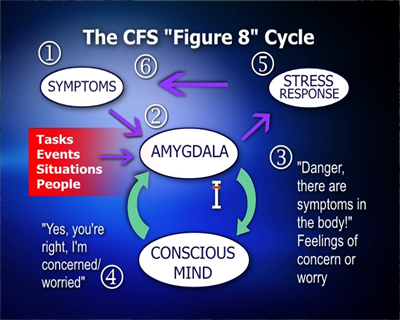
So the amygdala fears situations which may use up energy at a mental, physical or emotional level, and will react fearfully to those events and situations.
Therefore, I believe that most of the symptoms of ME/CFS and Fibromyalgia are caused by an unremitting stimulation of the stress response (which in medical terms is known as an overactive sympathetic arousal), due to a vicious cycle. There is also inappropriate triggering of some aspects of the immune system. This chronic response causes abnormalities in all other systems in the body, causing secondary illnesses in some cases. This may lead researchers to believe that a particular abnormality they have found is the cause of ME/CFS, when in fact it may simply be one piece of a bigger jigsaw puzzle. Further information is available in the medical paper which is online at www.guptaprogramme.com/html/medicalPaper.asp
Recovery Through Amygdala Retraining
The good news is that I believe that the amygdala can be retrained. 'Amygdala Retraining' involves a number of different tailored techniques to allow the conscious brain to have more control over the amygdala's responses. It incorporates NLP (Neuro-Linguistic Programming), meditation, breathing, self-awareness, and other techniques.
It is hypothesised that the amygdala is retrained via the following process. A 'safety neurone' is created from the pre-frontal cortex of the brain to the amygdala, to restrict the amygdala's over-zealous reactions.
I recently conducted a clinical audit involving 33 patients, and found that 90% of patients improved, and two-thirds of patients reached a full recovery (85-100% of pre-illness levels) within one year. The audit paper has been sent for publication and should be published in summer 2009. I am currently looking to partner with institutions to conduct a full medical trial of the techniques, so that these techniques can be independently assessed.
Given that patients with ME/CFS and Fibromyalgia often have limited funds, the recovery programme comes with a money back guarantee that if someone does not experience any improvement within 6 months, they can return it for a full refund.
I do believe that we are close to cracking the ME/CFS and Fibromyalgia conundrum, and I hope that the next few years will yield a breakthrough for patients.
References
1. Gupta, A. Unconscious Amygdalar Fear Conditioning in a Subset of Chronic Fatigue Syndrome Patients. Medical Hypotheses 59: Issue 6 727-735. 2002.
2. Ledoux J. The Emotional Brain. Weidenfeld & Nicolson. London. ISBN 0 75380 670 3. 1998.
Comments:
-
Terry Leggett said..
Very intreasting I have suffered from this awful thing since I contacted the swine flue back in 2010 I have got all sorts of hypersentivty reactions cfs hypothyriodim panic attacks depression I have been to heaps of specialists it has taken away my full time job and forced me in to working part time I have just lost my part time job and may start doing volunteer work there seems to be no end to this awful stuff